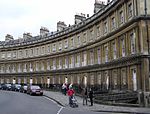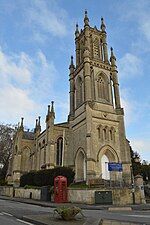Portland Place, Bath
Buildings and structures in Bath, SomersetGrade I listed buildings in Bath, SomersetSomerset building and structure stubsStreets in Bath, SomersetUnited Kingdom listed building stubs ... and 1 more
Use British English from April 2017

Portland Place in Bath, Somerset, England was built around 1786 and many of the houses have been designated as listed buildings. Numbers 1 to 10 including numbers 4 and 5 which were used as Hermitage House School are Grade I listed, as is the high pavement in front of them. In the centre of the steps is a double ramp which was built to enable easier access for sedan chairs.Numbers 13 to 16 are Grade II listed. Numbers 17 to 20 follow a similar style and are also Grade II listed. Numbers 17 and 20 have Roman Doric doorcases with pediments.
Excerpt from the Wikipedia article Portland Place, Bath (License: CC BY-SA 3.0, Authors, Images).Portland Place, Bath
Portland Place, Bath Walcot
Geographical coordinates (GPS) Address Nearby Places Show on map
Geographical coordinates (GPS)
| Latitude | Longitude |
|---|---|
| N 51.389444444444 ° | E -2.3641666666667 ° |
Address
Portland Place
Portland Place
BA1 2RY Bath, Walcot
England, United Kingdom
Open on Google Maps









